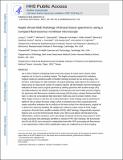Rapid virtual hematoxylin and eosin histology of breast tissue specimens using a compact fluorescence nonlinear microscope
Author(s)
Cahill, Lucas Christopher; Giacomelli, Michael; Yoshitake, Tadayuki; Vardeh, Hilde; Faulkner-Jones, Beverly E; Connolly, James L; Sun, Chi-Kuang; Fujimoto, James G; ... Show more Show less
DownloadAccepted version (3.444Mb)
Publisher Policy
Publisher Policy
Article is made available in accordance with the publisher's policy and may be subject to US copyright law. Please refer to the publisher's site for terms of use.
Terms of use
Metadata
Show full item recordAbstract
Up to 40% of patients undergoing breast conserving surgery for breast cancer require repeat surgeries due to close to or positive margins. The lengthy processing required for evaluating surgical margins by standard paraffin-embedded histology precludes its use during surgery and therefore, technologies for rapid evaluation of surgical pathology could improve the treatment of breast cancer by reducing the number of surgeries required. We demonstrate real-time histological evaluation of breast cancer surgical specimens by staining specimens with acridine orange (AO) and sulforhodamine 101 (SR101) analogously to hematoxylin and eosin (H&E) and then imaging the specimens with fluorescence nonlinear microscopy (NLM) using a compact femtosecond fiber laser. A video-rate computational light absorption model was used to produce realistic virtual H&E images of tissue in real time and in three dimensions. NLM imaging could be performed to depths of 100 μm below the tissue surface, which is important since many surgical specimens require subsurface evaluation due to contamination artifacts on the tissue surface from electrocautery, surgical ink, or debris from specimen handling. We validate this method by expert review of NLM images compared to formalin-fixed, paraffin-embedded (FFPE) H&E histology. Diagnostically important features such as normal terminal ductal lobular units, fibrous and adipose stromal parenchyma, inflammation, invasive carcinoma, and in situ lobular and ductal carcinoma were present in NLM images associated with pathologies identified on standard FFPE H&E histology. We demonstrate that AO and SR101 were extracted to undetectable levels after FFPE processing and fluorescence in situ hybridization (FISH) HER2 amplification status was unaffected by the NLM imaging protocol. This method potentially enables cost-effective, real-time histological guidance of surgical resections.
Date issued
2017-11Department
Massachusetts Institute of Technology. Research Laboratory of Electronics; Massachusetts Institute of Technology. Department of Electrical Engineering and Computer ScienceJournal
Laboratory Investigation
Publisher
Springer Science and Business Media LLC
Citation
Cahill, Lucas C. et al. "Rapid virtual hematoxylin and eosin histology of breast tissue specimens using a compact fluorescence nonlinear microscope." Laboratory Investigation 98, 1 (November 2017): 150–160 © 2018 USCAP, Inc
Version: Author's final manuscript
ISSN
0023-6837
1530-0307